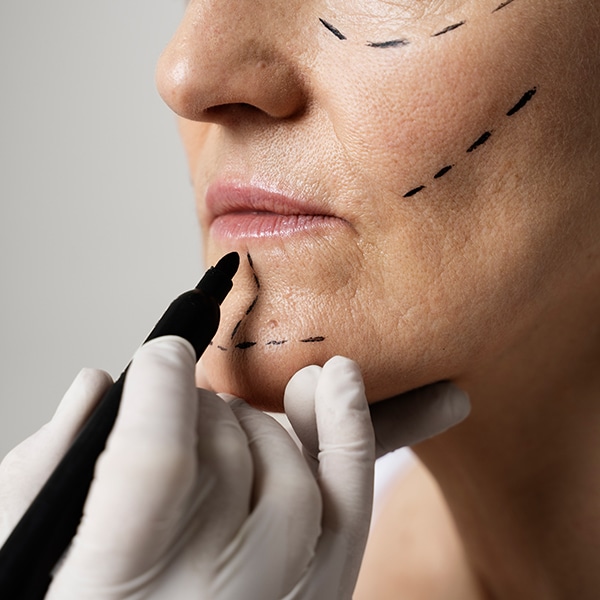Facial Reconstruction
Facial reconstructive surgery aims to repair or improve the function and appearance of the face, and it can be performed for functional or cosmetic reasons. Functional facial reconstructive surgery is usually performed to correct congenital disabilities, such as cleft lip and palate, or repair damage from an accident. Cosmetic surgery may be done on the face to reduce the signs of aging, such as wrinkles and sagging skin, or to change the shape of the nose, chin, or other facial features.
To learn more about our facial reconstructive procedures in Bakersfield and to schedule a consultation with Dr. Freeman. Fill out the contact form.

Is it For Me?
A good candidate for facial reconstruction surgery is someone who has a deformity or disfigurement that affects their appearance and self-confidence. The goal of surgery is to restore function and improve appearance, self-esteem, and confidence.
Facial reconstructive surgery is a highly personalized treatment, so it’s important to consult with a board-certified surgeon who has experience performing the surgery you need. Dr. Freeman and his staff will be happy to share their experience, training, and credentials to give you peace of mind when choosing the right surgeon.
How Much Does it Cost?
The cost of facial reconstructive surgery depends on the type of procedure being performed and other factors such as the surgeon’s fees, the facility where the surgery will be performed, and whether you need to stay overnight in the hospital. In general, cosmetic procedures are not covered by insurance, while functional facial procedures after an accident or to correct a congenital disability may be partially or fully covered by your healthcare provider.
Procedures
The type of facial reconstructive surgery needed will depend on the individual’s specific condition or trauma. Many different reconstructive surgeries can be done on the face with excellent outcomes.
Some standard procedures include the following:
Facial burns
Facial burns are often treated with skin grafts, which involve taking healthy skin from another area of the body and attaching it to the burned area. The skin used for a graft will often come from the patient’s thigh, buttock, or lower abdomen. Then, the graft is covered with a dressing and left to heal. The area may be sore for one to two weeks. As the area heals, it can take weeks to months for feeling to return to the area.
Scar Revision
While there are no medical or surgical techniques that can altogether remove a scar, facial reconstructive surgeons may be able to improve the comfort and appearance of a scar by making it less apparent or easier to conceal. Dermabrasion, laser resurfacing, and excision are all standard methods of scar revision.
Facial Paralysis Surgery
If you have facial paralysis, several surgical methods can be used to improve the function and appearance of your face. One common type of surgery is static sling surgery, which involves placing a piece of silicone rubber underneath the skin to help support the affected muscles.
Another option is free muscle transfer, which involves taking a healthy muscle from another body area and attaching it to the paralyzed muscle. This surgery can help improve facial movement.
Lacerations
Lacerations, or cuts, to the face are often treated with sutures, which are tiny stitches that help hold the skin together as it heals. The sutures will need to be removed after five to seven days. If the laceration is deep, a skin graft may be used to help improve the appearance of the scar.
Facial Fractures
Facial fractures can often be treated with metal plates and screws placed underneath the skin to hold the bones in place as they heal. In some cases, a bone graft may be necessary to help fill in any voids or spaces created by the fracture. A bone graft can be taken from another area of the body or made from synthetic material.
Cleft Lip and Palate
Cleft lip and palate surgery are usually performed in two stages. The first stage is done when the child is 3 to 6 months old and involves surgery to close the palate. The second stage involves surgery to close the cleft lip. The surgery is performed under general anesthesia and takes about two hours.
Deviated Septum
A deviated septum is when the bone and cartilage that divide the nostrils are off to one side. This can cause difficulty breathing and lead to other problems, such as nosebleeds.
Surgery to correct a deviated septum is called a septoplasty. The surgeon will make an incision in the nostril and then reposition the bone and cartilage to the middle. The incision is then closed with stitches.
Tumor Removal (Mohs Surgery)
Mohs surgery is a type of skin cancer treatment that involves removing the cancerous tissue one layer at a time. This allows the surgeon to see if all of the cancerous tissue has been removed before moving on to the next layer. Mohs surgery is often used for cancers located in difficult-to-reach areas, such as the nose. The surgery can take several hours, and you may need to return for additional treatments.
Synkinesis
Synkinesis is a condition that can arise after facial nerve surgery. It causes the muscles on one side of the face to move when the muscles on the other side are moved. This can cause problems with smiling, blinking, and other facial expressions. Surgery to correct synkinesis is called muscle reanimation. The surgeon will make an incision in the affected area and then reattach the muscles to the facial nerve.
Scarring
Scarring is a common side effect of facial reconstructive surgery. The amount of scarring will depend on the surgery that was performed and the location on the face. Scarring can often be treated with topical treatments, such as silicone gel or cream. In some cases, laser treatment can help improve the appearance of scars.
Risks vs. Reward
Facial reconstructive procedures do come with risks. The most common complications include infection, bleeding, and scarring. There is also a risk of nerve damage, which can cause numbness or paralysis of the face. Although risks are present, the rewards can be life-changing. For many people, facial reconstructive surgery can improve the function and appearance of the face, which can boost self-confidence and quality of life.

Be Your Best Version
Facial reconstructive surgery doesn’t have to be scary. Dr. Freeman understands your concerns and will work hard to ensure that you’re as comfortable as possible during the procedure. Our team works hard to make sure you are well informed and comfortable through the entire process- from the consultation to the procedure to recovery. Take the first step towards a better you today by contacting us to learn more about our facial reconstructive procedures in Bakersfield and to schedule a consultation with Dr. Freeman. Fill out the contact form.
Frequently Asked Questions
If you have suffered facial fractures or other head trauma caused by an accident, disease, or birth deformities, now may be the time to address your concerns. Facial reconstructive surgeons are specially trained in restoring facial features and can restore both function (blinking, smiling, talking, and eating) and appearance.
During your first consultation, you can expect to discuss your concerns and what outcomes you are hoping to achieve. Other things to be discussed will be things like reviewing your medical history, seeing before and after photos from past patients who had the same procedure, and discussing any other potential surgical options.
Pain is subjective to each person based on their perception and sensitivity. The amount of pain you will experience also depends on the surgery. Most patients report minimal pain and discomfort after surgery.
